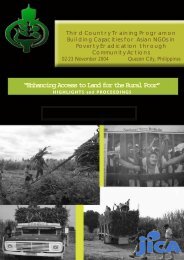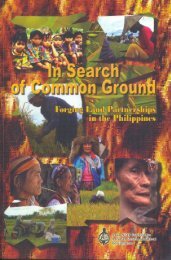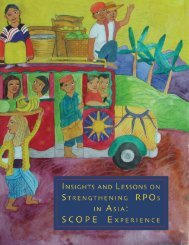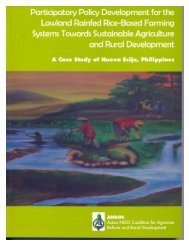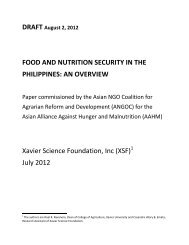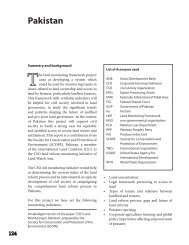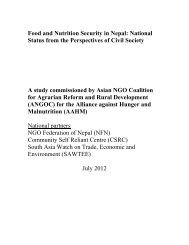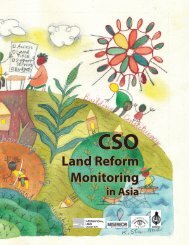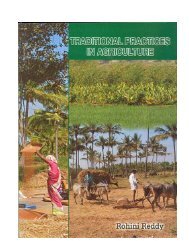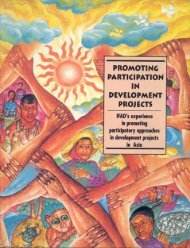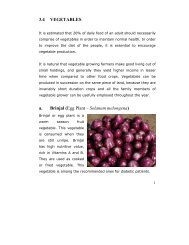Securing the Right to Land FULL - ANGOC
Securing the Right to Land FULL - ANGOC
Securing the Right to Land FULL - ANGOC
Create successful ePaper yourself
Turn your PDF publications into a flip-book with our unique Google optimized e-Paper software.
During this phase of uncertainty, President Susilo Bambang<br />
Yudhoyono has propounded a model for agricultural development<br />
that does not address issues concerning land. Critics are saying<br />
that seeking <strong>to</strong> revitalize agriculture without land reform is like<br />
going through <strong>the</strong> Green Revolution for <strong>the</strong> second time.<br />
Issues Affecting Access <strong>to</strong> <strong>Land</strong><br />
and Tenurial Security<br />
The Abandonment of <strong>the</strong> Agrarian Reform Agenda<br />
by <strong>the</strong> New Order Regime (1966–1998)<br />
The Old Order era (1962–1967) and <strong>the</strong> New Order Regime<br />
(1968–1998) operated under <strong>the</strong> same legal framework for<br />
implementing agrarian reform. But while <strong>the</strong> former was able <strong>to</strong><br />
make some progress in redistributing land (as Table 2 shows)—<br />
even though it was ill-matched against anti-reform forces—<br />
agrarian reform under <strong>the</strong> New Order Regime was an utter<br />
failure, in all respects—economic, political, and social—because<br />
it was reduced by Suhar<strong>to</strong> <strong>to</strong> land administration that benefitted<br />
elite interests.<br />
<strong>Land</strong>lord opposition was <strong>the</strong> major stumbling block <strong>to</strong> <strong>the</strong> implementation<br />
of agrarian reform during <strong>the</strong> Old Order Era. The<br />
o<strong>the</strong>r constraints were lack of political support for <strong>the</strong> program;<br />
weak land administration systems; policy flaws; lack of funding;<br />
and <strong>the</strong> unavailability of agricultural lands for distribution.<br />
In 1966, <strong>the</strong> anti-reform forces wrested power from <strong>the</strong>n President<br />
Sukarno, and <strong>to</strong>ok over leadership of what was <strong>to</strong> become<br />
<strong>the</strong> New Order Regime. The agrarian reform program was revoked,<br />
and <strong>the</strong> recipients of land under <strong>the</strong> Old Order, and who were<br />
identified with <strong>the</strong> Indonesia Peasant Front (BTI)—a left-leaning<br />
peasant organization—became <strong>the</strong> targets of attack by access <strong>to</strong><br />
THE PERSISTENCE OF POPULAR WILL<br />
95<br />
records <strong>the</strong> military. In fact, <strong>the</strong> land grabbing campaign subsequently<br />
launched by <strong>the</strong> military was facilitated by records of<br />
where land had been distributed, and <strong>to</strong> which families.<br />
One by one, <strong>the</strong> New Order regime revoked agrarian reform<br />
regulations. In 1970 it abolished <strong>the</strong> <strong>Land</strong> Reform Court, and<br />
disbanded <strong>the</strong> <strong>Land</strong> Reform Committee.<br />
However, nei<strong>the</strong>r regime ever attempted <strong>to</strong> repeal or amend<br />
<strong>the</strong> Basic Agrarian Law of 1960, whose provisions are quite<br />
progressive, because <strong>the</strong>ir leaders knew that it would trigger<br />
mass protests.<br />
Dr. Sadjarwo, Minister of Agrarian Affairs of Indonesia, has identified<br />
<strong>the</strong> following stumbling blocks in implementing agrarian<br />
reform in Indonesia:<br />
The ineffectiveness of land administration made it difficult<br />
<strong>to</strong> determine how much land was available for distribution<br />
under <strong>the</strong> agrarian reform program. This opened up opportunities<br />
for many deviations—wittingly or not;<br />
The public has not fully appreciated <strong>the</strong> need for agrarian<br />
reform <strong>to</strong> complete <strong>the</strong> country’s “revolution” for poverty<br />
eradication. Agrarian reform is blamed on any pretext;<br />
Committee members have shown little interest in agrarian<br />
reform, ei<strong>the</strong>r because <strong>the</strong>y are o<strong>the</strong>rwise preoccupied or<br />
because it goes against <strong>the</strong>ir self-interest. This negligence<br />
on <strong>the</strong> part of Committee members has been blamed for <strong>the</strong><br />
tampering of land registration records, such that names of<br />
registrants have been deleted from <strong>the</strong> land lists, or addresses<br />
of registrants are mixed up;<br />
Peasant mass organizations that are supposed <strong>to</strong> provide<br />
support and oversight are not sufficiently represented in<br />
land reform committees at <strong>the</strong> regional level;<br />
The agrarian reform lobby is still not strong enough <strong>to</strong> with-<br />
Table 2. Comparative Accomplishments of <strong>Land</strong> Reform, by Political Regime<br />
Political Regime and <strong>Land</strong>s Redistributed Number of Agrarian Average <strong>Land</strong> Size<br />
Years of Implementation (in hectares) Reform Beneficiaries Received<br />
(families) (in hectares)<br />
Old Order (1962–1967), 5 years 801,317 847,912 0.95<br />
New Order and its Successors<br />
(1968–2005), 37 years 358,210 662,850 0.54<br />
Total in 42 years (1962–2005) 1,159,527 1,510,762 0.76<br />
Source: Calculated by Erpan Faryadi from Utrecht (1969) and <strong>the</strong> Indonesian Government Report at ICARRD (2006).<br />
ASIAN NGO COALITION FOR AGRARIAN REFORM AND RURAL DEVELOPMENT



